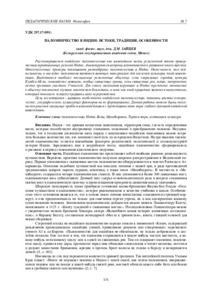Please use this identifier to cite or link to this item:
https://elib.psu.by/handle/123456789/20552| Title: | Паломничество в Индии: истоки, традиция, особенности |
| Authors: | Зайцев, Д. М. |
| Issue Date: | 2017 |
| Publisher: | Полоцкий государственный университет |
| Citation: | Вестник Полоцкого государственного университета. Серия E, Педагогические науки. - 2017. - № 7. - С. 131-135. |
| Abstract: | Рассматривается индийское паломничество как важнейшая часть религиозной жизни приверженцев традиционных религий Индии. Анализируются вопросы возникновения и развития этого явления. Многочисленные примеры показывают разнообразие паломничества в Индии. Отмечается, что деятельность и наследие паломников являются важным материалом для изучения культуры этой цивилизации. Выделяются наиболее посещаемые религиозные объекты: семь сакральных городов, центры Кумбха-Мела, гималайские святыни, особые священные храмы, семь священных рек, мощи, захоронения, места кремации ушедших Учителей. Для сотен миллионов верующих в Индии трепетное отношение к объекту поклонения служит накоплению благодати, а тот или иной праведник является заступником, который помогает человеку прервать цикл перерождения. Цель исследования – выявить особенности индийского паломничества, показать влияние исторических, географических, культурных факторов на их формирование. Данная работа может быть полезна для решения насущных проблем взаимодействия с представителями мира глубоко духовной индийской цивилизации.= The article considers the Indian pilgrimage as an important part of the religious life of adherents of the traditional religions of India. The problems of occurrence and development of this phenomenon are analyzed. Numerous examples show the diversity of pilgrimage in India. It is noted that the activities and heritage of pilgrims are an important material for studying the culture of this civilization. The most visited religious objects are singled out: seven sacral cities, Kumbh-Mela centers, Himalayan shrines, special sacred temples, seven sacred rivers, relics, burial places, and places for cremation of the departed Masters. For hundreds of millions of believers in India, a reverent attitude to the object of worship serves the accumulation of grace, and this or that righteous person is an intercessor who helps a person break the cycle of rebirth. The purpose of the research is to reveal the peculiarities of Indian pilgrimage, to show the influence of historical, geographical, cultural factors on their formation. This work can be useful for solving pressing problems of interaction with representatives of the world of a deeply spiritual Indian civilization. |
| Keywords: | Паломничество Индия Веды Махабхарата Тиртха-ятра Медитация Культура Pilgrimage India Vedas Mahabharata Tirtha-yatra Meditation Culture |
| URI: | https://elib.psu.by/handle/123456789/20552 |
| metadata.dc.rights: | open access |
| Appears in Collections: | 2017, № 7 |
Files in This Item:
| File | Description | Size | Format | |
|---|---|---|---|---|
| 131-135.pdf | 174.83 kB | Adobe PDF |  View/Open |
Items in DSpace are protected by copyright, with all rights reserved, unless otherwise indicated.